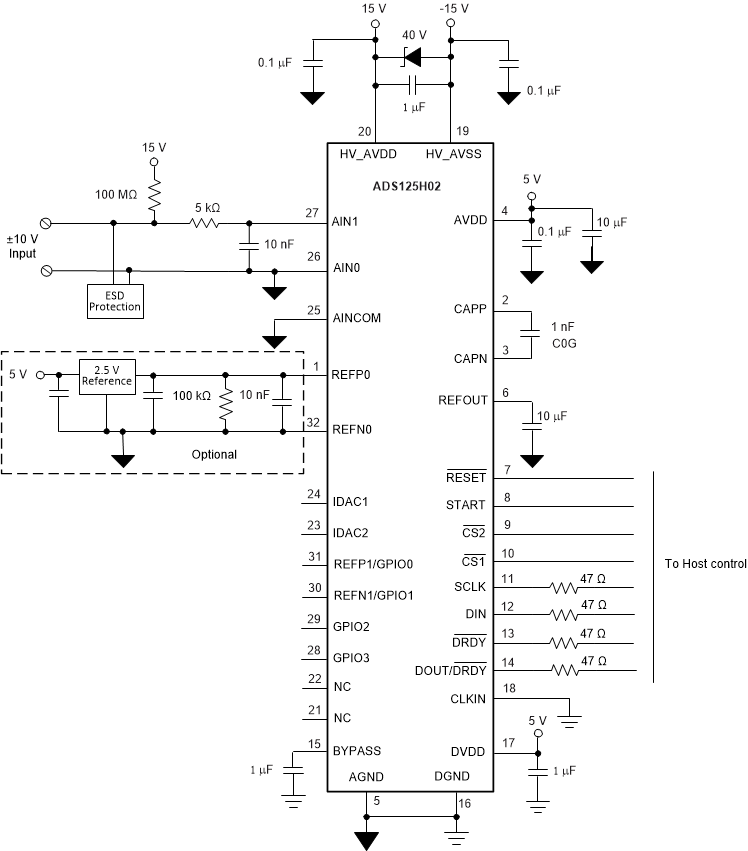ZHCSIZ6C October 2018 – June 2019 ADS125H02
PRODUCTION DATA.
- 1 特性
- 2 应用
- 3 说明
- 4 修订历史记录
- 5 Device Comparison Table
- 6 Pin Configuration and Functions
- 7 Specifications
- 8 Parameter Measurement Information
-
9 Detailed Description
- 9.1 Overview
- 9.2 Functional Block Diagram
- 9.3 Feature Description
- 9.4 Device Functional Modes
- 9.5 Programming
- 9.6
Register Map
- 9.6.1 Device Identification (ID) Register (address = 00h) [reset = 6xh]
- 9.6.2 Main Status (STATUS0) Register (address = 01h) [reset = 01h]
- 9.6.3 Mode 0 (MODE0) Register (address = 02h) [reset = 24h]
- 9.6.4 Mode 1 (MODE1) Register (address = 03h) [reset = 01h]
- 9.6.5 Mode 2 (MODE2) Register (address = 04h) [reset = 00h]
- 9.6.6 Mode 3 (MODE3) Register (address = 05h) [reset = 00h]
- 9.6.7 Reference Configuration (REF) Register (address = 06h) [reset = 05h]
- 9.6.8 Offset Calibration (OFCALx) Registers (address = 07h, 08h, 09h) [reset = 00h, 00h, 00h]
- 9.6.9 Full-Scale Calibration (FSCALx) Registers (address = 0Ah, 0Bh, 0Ch) [reset = 00h, 00h, 40h]
- 9.6.10 Current Source Multiplexer (I_MUX) Register (address = 0Dh) [reset = FFh]
- 9.6.11 Current Source Magnitude (I_MAG) Register (address = 0Eh) [reset = 00h]
- 9.6.12 Reserved (RESERVED) Register (address = 0Fh) [reset = 00h]
- 9.6.13 MODE4 (MODE4) Register (address = 10h) [reset = 50h]
- 9.6.14 PGA Alarm (STATUS1) Register (address = 11h) [reset = xxh]
- 9.6.15 Status 2 (STATUS2) Register (address = 12h) [reset = 0xh]
- 10Application and Implementation
- 11Power Supply Recommendations
- 12Layout
- 13器件和文档支持
- 14机械、封装和可订购信息
10.2.1 ±10-V Analog Input Module
Figure 98 illustrates an example of the ADS125H02 used in a ±10-V analog input programmable logic controller (PLC) module. The inputs of the ADC are protected by external ESD diodes to provide system-level protection. A 100-MΩ resistor is used to pull the positive analog input to 15 V if the field-wiring connection is open or the transmitter has failed in open-circuit mode.
The signal from the transmitter is filtered to remove EMI and RFI interference when operated in noisy environments. The resistor also acts to limit the input current in the event of an input overvoltage, including if the module loses power with the signal present. The negative input signal is connected to AIN0, which is also connected to AGND. Connection to AGND is necessary if the sensor power supply is not referenced to the ADC ground.
The ADC measures the differential voltage between inputs AIN1 and AIN0. The input configuration is single-ended with the input voltage driven ±10 V relative to AIN0 (AGND).
Operation by internal reference requires a 10-µF capacitor connected to the REFOUT pin. Otherwise, apply the external reference voltage to REFP0 and REFN0. A 100-kΩ resistor biases the differential reference voltage to 0 V. The resistor provides the bias to allow the reference monitor to detect a failed or missing reference voltage that otherwise may be unnoticed.
Because the excitation current sources and GPIOs are not used they are left unconnected.
The internal oscillator is selected by connecting the CLKIN input pin to ground. The serial interface and digital control lines of the ADC are connected to the host.
The zener diode clamps the high-voltage supply (HV_AVDD – HV_AVSS) to 40 V to provide overvoltage protection if an input signal is present with module power off.
 Figure 98. ±10-V Analog Input PLC Module
Figure 98. ±10-V Analog Input PLC Module